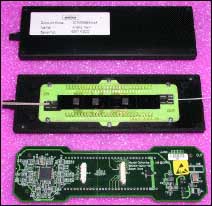
Alcatel Optronics
1910 TWV Multiplexer
 The 1910 TWV eight-channel, wavelength-independent multiplexer from Alcatel Optronics, headquartered at Nozay, France, demonstrates the concept of integrated planar lightwave hybridization. It is designed to overcome the telecommunications challenge of managing complex optical functions with reduced volume, cost and power dissipation. It allows the monitoring and power adjustment of eight high-bit-rate channels before multiplexing and is dedicated to terminal or optical add/drop equipment.
The 1910 TWV eight-channel, wavelength-independent multiplexer from Alcatel Optronics, headquartered at Nozay, France, demonstrates the concept of integrated planar lightwave hybridization. It is designed to overcome the telecommunications challenge of managing complex optical functions with reduced volume, cost and power dissipation. It allows the monitoring and power adjustment of eight high-bit-rate channels before multiplexing and is dedicated to terminal or optical add/drop equipment.
The 1910 TWV integrates power taps, photodetectors, variable optical attenuators and multiplexing functionality to form a highly compact package. It uses a silica-on-silicon planar platform as a motherboard for passive-component integration and active hybridization. During assembly, the photodetectors and MEMS variable optical attenuators are flip-chip bonded onto the motherboard, the input/output fibers are attached, and the device is integrated with its control electronics. The current device features 41 optical functions on a single 9 x 1.4 cm2 die.
The functions incorporate eight input and eight output power taps with associated photodetectors, eight MEMS-based variable optical attenuators, an 8:1 multiplexer combiner and integrated drive electronics.
The company says the Alcatel 1910 TWV is a breakthrough in active-passive integration that opens the way to added-value integrated functions in future system design.
/Buyers_Guide/Alcatel_Submarine_Networks/c515